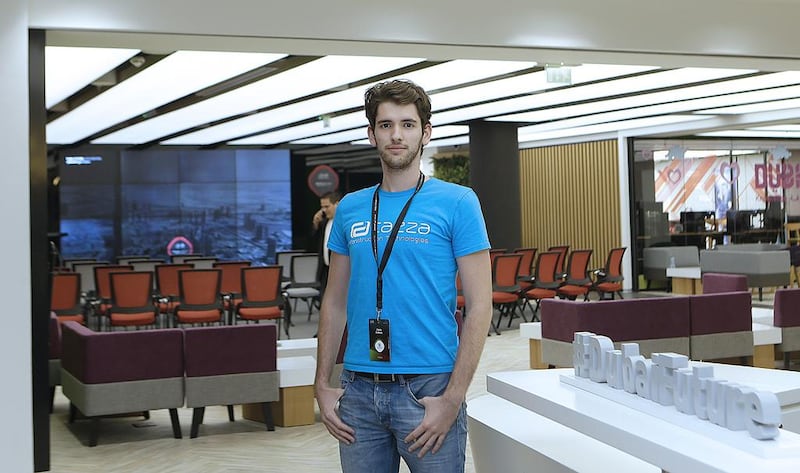A teenager who has relocated his start-up business in 3D printing technology from Silicon Valley to Dubai has said that it is ready to begin offering 3D printed houses and buildings.
Chris Kelsey, 19, the co-founder and chief executive of Cazza Construction Technologies, has said that its mobile printing robots are capable of printing a 200 square metre house in a single day using just two workers – one to monitor the machine and another to add elements such as steel rebar and electricity cables within pre-determined sections.
“If someone wants to build a house, we design and engineer according to 3D standards. From there we bring the machine on site and set up the position where it is meant to print. Once it is in position, the machine 3D prints according to the software design,” he said.
Mr Kelsey, who was born in Pennsylvania and grew up in California, began to seriously look at the market for 3D printing in construction early last year, using the proceeds generated from the sale of an earlier company – an app and website development business known as Appsitude.
He said that he “wanted to change the world” and had created Appsitude to generate funds to develop “dream ideas”. When he sold the business, he planned to invest in a company developing technology in 3D printing, but when he couldn’t find anything suitable he set up his own firm.
His plan involves developing different types of machines for different purposes. Alongside the on-site 3D printing machines, which he said are capable, with supporting equipment, of building skyscrapers and of working in remote locations, Cazza is also developing larger, factory-based machines that can custom-make other home elements.
He declined to say how much the company has invested in its technology to date but said that developing a company creating hardware such as robots is considerably more expensive than software development. Cazza will also eventually sell its machines to interested parties.
Mr Kelsey said that the difference between his technology and other nascent 3D construction companies lies partly in the formula it has created and in its ability to deliver smooth, finished concrete surfaces. He also said the mobility of its on-site robots, known as Minitanks, give it a greater flexibility to build vertically.
Although 3D printing is more expensive than building using traditional methods, Mr Kelsey expects this to change.
“The cost of labour is increasing and we feel that is going to increase more over time. And even if it doesn’t, I still think that people will see that it is more efficient to use the machines.”
In December, Cazza agreed to collaborate with the Dubai Government on 3D printing technologies and it has been enrolled in the Dubai Future Accelerators programme. Once the programme is complete, it is expected to sign a memorandum of understanding with Dubai Municipality.
He is also helping Dubai Municipality to formulate new laws and building codes specifically relating to the use of 3D printing in construction. Dubai has already set a target for 25 per cent of buildings to be 3D-printed by 2030. Mr Kelsey said that this process effectively begins in 2019, when buildings will need 2 per cent of 3D-printed elements to gain municipality approval, with this figure stepping up each year until eventually reaching 25 per cent by 2030.
“There’s a huge disruption that’s about to happen with this technology,” he said.
A report by BMI Research in December predicted that 3D printing will be transformative for the construction sector. It said that despite high upfront investment costs, “the technology has the potential to cut construction costs … over the next five years” by replacing the need for many skilled labour roles, and reducing the amount of materials wasted using traditional methods.
mfahy@thenational.ae
Follow The National's Business section on Twitter







